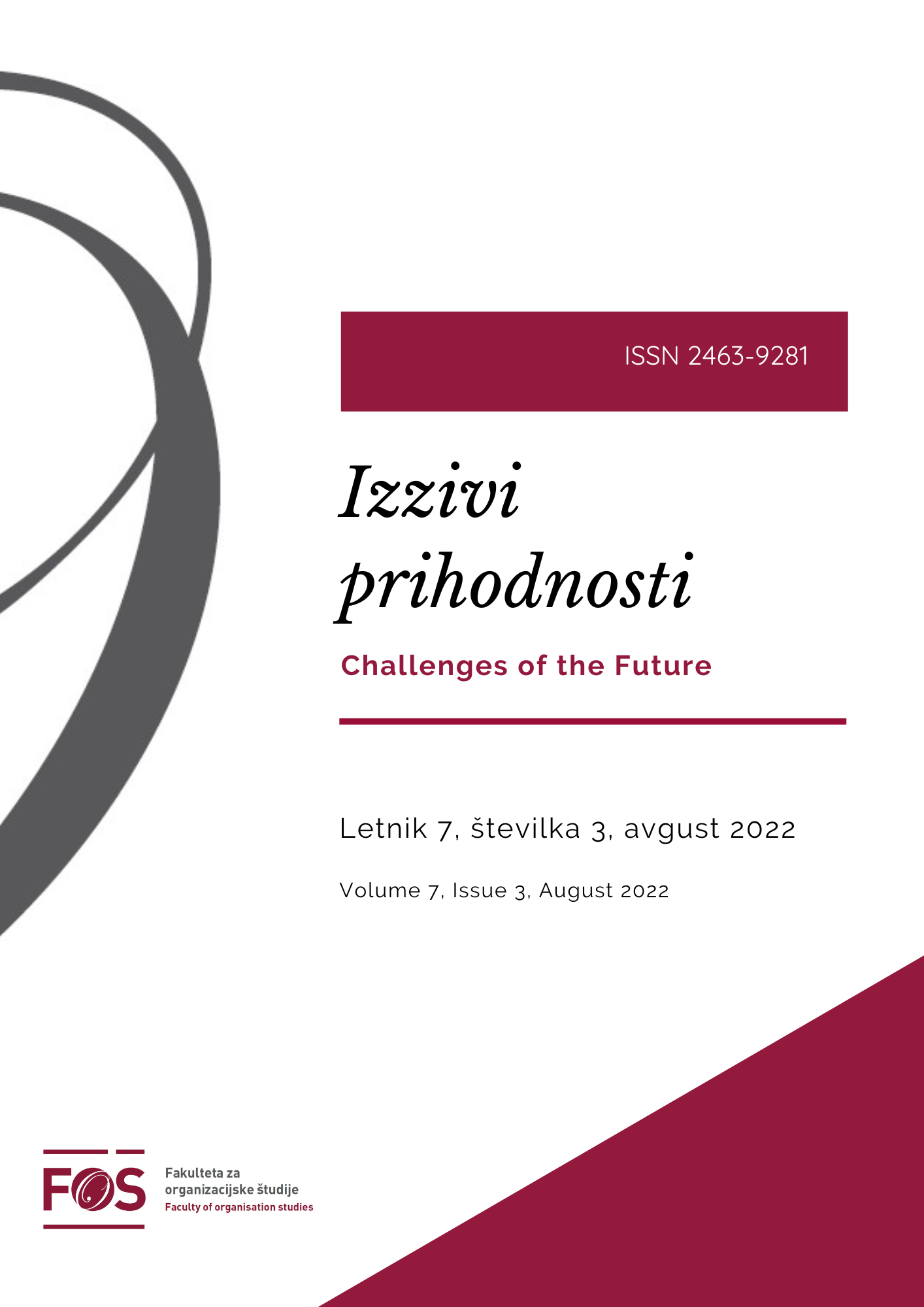Motivation, satisfaction and engagement of older employees during COVID-19 pandemic
DOI:
https://doi.org/10.37886/ip.2022.006Keywords:
Delovna motivacija, zadovoljstvo, zavzetost, starejši zaposleni, COVID-19Abstract
Research Question (RQ): Are there statistically significant differences in work motivation, satisfaction and engagement among older employees before the COVID-19 pandemic and during the COVID-19 pandemic?
Purpose: The aim of the paper is to examine if there are statistically significant differences in work motivation, satisfaction and engagement among older employees before the COVID-19 pandemic and during the COVID-19 pandemic. The aim of the paper is also to identify which factors contribute to increasing work motivation, satisfaction and engagement during the COVID-19 pandemic.
Method: The differences in work motivation, satisfaction and engagement among older employees before the COVID-19 pandemic and during the COVID-19 pandemic were tested with the nonparametric test for two related samples. To analyze the differences between individual statements, we used the non-parametric Wilcoxon signed-rank test.
Results: The results show that there are statistically significant differences in work motivation, satisfaction and engagement among older employees before the COVID-19 pandemic as compared to the during COVID-19 pandemic.
Organisation: The results have a significant impact on a more detailed review of the creation of new working conditions for employees during the Covid-19 pandemic and especially in the period after the Covid-19 pandemic.
Society: During the COVID-19 pandemic, companies and society can focus on how to constructively manage the new challenges that the COVID-19 pandemic brings to companies and what they can learn from it. For companies and leaders or HRM in particular, the pandemic can be used as a starting point for positive and future-oriented developments.
Originality: With our findings we contribute to the discussion on a constructive and future oriented approach to the COVID-19 pandemic, both for practices around the management of employees as well as for future research. Also, our research highlights which factors increase work motivation, work satisfaction and work engagement during COVID-19 and how to create appropriate working conditions during the COVID-19 and after the COVID-19 pandemic to keep employees motivated, satisfied and engaged.
Limitations/further research: Our sample was limited to Slovenian companies and older employees. Also, in our research we limited on work motivation, work satisfaction and work engagement. Therefore, for further research we propose the examination of differences in others constructs before the COVID-19 pandemic and employees during the COVID-19 pandemic in Slovenian companies and also, the examination of differences in constructs between Slovenia and other countries.
References
Agrawal, S., A. De Smet, S. Lacroix, & Reich, A. (2020). To Emerge Stronger from the COVID-19 Crisis, Companies Should Start Reskilling Their Workforces Now. Washington: McKinsey & Company.
Bayuni, E. (2020). COVID-19 lockdown? It’s not the economy. It’s people’s health and lives! Retrieved from: https://www.thejakartapost.com/ academia/2020/03/17/covid-19-lockdown-its-not-theeconomy-stupid-its-peoples-health-and-lives.html
Bellmann, L., & Hübler, O. (2020). Job Satisfaction and Work-Life Balance: Differences between Homework and Work at the Workplace of the Company. Retrieved from: http://ftp.iza.org/dp13504.pdf
Bhatti, O. K., Aslam, U. S., Hassan, A., & Sulaiman, M. (2016). Employee motivation: An Islamic perspective. Humanomics, 32(1), 33–47. https://doi.org/10.1108/H-10-2015-0066
Brassey, J., & Kruyt, M. (2020). How to Demonstrate Calm and Optimism in a Crisis. Organization Practice. New York: McKinsey & Company.
Chanana, N., & Sangeeta, M. (2020). Employee engagement practices during COVID-19 lockdown. Retrieved from: https://www.ncbi.nlm.nih.gov/pmc/articles/PMC7536939/pdf/PA-9999-e2508.pdf
Culbertson, S. (2009). Do satisfied employees mean satisfied customers? Academy of Management Perspectives, 23(1), 76–77. https://doi.org/10.5465/amp.2009.37008005
D’Auria, G., & De Smet, A. (2020). Leadership in a Crisis: Responding to the Coronavirus Outbreak and Future Challenges. Retrieved from: https://www.mckinsey.com/business-functions/organization/our-insights/leadership-in-a-crisis-responding-to-the-coronavirus-outbreak-and-future-challenges
Fachriansyah, R. (2020). Work-from-home policy in effect at major Jakarta companies over virus concerns. Retrieved from: https://www.thejakartapost.com/ news/2020/03/15/work-from-home-policy-in-effect-at-majorjakarta-companies-over-virus-concerns.html
Farrell, L., Newman, T., & Corbel, C. (2020). Literacy and the workplace revolution: a social view of literate work practices in Industry 4.0. Discourse: Studies in the Cultural Politics of Education. Retrieved from: https://www.researchgate.net/publication/341154956_Literacy_and_the_workplace_revolution_a_social_view_of_literate_work_practices_in_Industry_40 Festing, M., Kraus, S. A. (2020). The impact of the COVID-19 pandemic on global employees. Retrieved from: https://academ.escpeurope.eu/pub/IP%202020-19-EN_CHAIR.pdf
Ferfoglia, P. & Markič, M. (2020). Primerjava zadovoljstva zaposlenih s kakovostjo delovnega in življenjskega okolja. Revija za univerzalno odličnost, 4, 309–324. https://doi.org/10.37886/ruo.2020.019
Gallup, G. (2006). Q12 Meta-Analysis. The relationship between engagement at work and organizational outcomes. Retrieved from: https://www.hrbartender.com/images/Gallup.pdf
Harter, J. (2020). U.S. Employee Engagement Reverts Back to Pre-COVID-19 Levels. Retrieved from: https://www.gallup.com/workplace/321965/employee-engagement-reverts-back-pre-covid-levels.aspx
Hayday. (2003). Questions to Measure Commitment and Job Satisfaction. Retrieved from: https://www.employment-studies.co.uk/system/files/resources/files/mp19.pdf
Islam, R., & Ismail, A. Z. H. (2008). Employee motivation: A Malaysian perspective. International Journal of Commerce and Management, 18(4), 344–362. https://doi.org/10.1108/10569210810921960
Kozole, M. & Gračner, T. (2020). Menedžment dobrega počutja. Revija za univerzalno odličnost, 1, 31–47. https://doi.org/10.37886/ruo.2020.003
Matli, W. (2020). The changing work landscape as a result of the Covid-19 pandemic: insights from remote workers life situations in South Africa. International Journal of Sociology and Social Policy, 40(9/10), 1237–1256. https://doi.org/10.1108/IJSSP-08-2020-0386
May, D. R., Gilson, R. L., & Harter, L. M. (2004). The psychological conditions of meaningfulness, safety and availability and the engagement of the human spirit at work. Journal of Occupational and Organizational Psychology, 77(1), 11–37. https://doi.org/10.1348/096317904322915892
Menezes, L. M. (2012). Job satisfaction and quality management: an empirical analysis. International Journal of Operations & Production Management, 32(3), 308–328. https://doi.org/10.1108/01443571211212592
Nagel, L. (2020). The influence of the COVID-19 pandemic on the digital transformation of work. International Journal of Sociology and Social Policy, 40 (9/10), 861–875. https://doi.org/10.1108/IJSSP-07-2020-0323
Pancasila, I., Haryono, S., & Sulistyo, B. A. (2020). Effects of Work Motivation and Leadership toward Work Satisfaction and Employee Performance: Evidence from Indonesia. Journal of Asian Finance, Economics and Business, 7(6), 387–397. https://doi.org/10.13106/jafeb.2020.vol7.no6.387
Rafferty, A. E., Griffin, M. A. (2009). Job satisfaction in organizational research. In The Sage Handbook of Organizational Research Methods. USA: Sage Publications Ltd.: Thousand Oaks.
Robinson, D., Perryman, S., & Hayday, S. (2004). The drivers of employee engagement. Retrieved from: http://www.employmentstudies.co.uk/report-summary-drivers-employee-engagement
Sarangi, P., & Nayak, B. (2016). Employee engagement and its impact on organizational success–A study in manufacturing company, India. IOSR Journal of Business and Management, 18(4), 52–57. https://doi.org/10.9790/487X-1804015257
Schaufeli, W. B., Martinez, I. M., Pinto, A. M., Salanova, M., Bakker, A. B. (2002). Burnout and engagement in university students: A crossnational study. Journal of Cross-Cultural Psychology, 33(5), 464–481. https://doi.org/10.1177/0022022102033005003
Spurka, D., & Straub, C. (2020). Flexible employment relationships and careers in times of the COVID-19 pandemic. Journal of Vocational Behavior, 119, 1–5. https://doi.org/10.1016/j.jvb.2020.103435
Stergioua, D. P., & Farmaki, A. (2021). Ability and willingness to work during COVID-19 pandemic: Perspectives of front-line hotel employees. International Journal of Hospitality Management, 93, 1–4. https://doi.org/10.1016/j.ijhm.2020.102770
Sulaymonov, A. (2020). Flexible Working Practices: Urgency or Future? Modern Economy, 11(7), 1342–1350. doi: 10.4236/me.2020.117095.
Tabachnick, B. G., Fidell, L. S. (2013). Using multivariate statistics (6th Edition). Boston: Pearson Education.
Toscano, F., & Zappalà, S. (2020). Social Isolation and Stress as Predictors of Productivity Perception and Remote Work Satisfaction during the COVID-19 Pandemic: The Role of Concern about the Virus in a Moderated Double Mediation. Sustainability, 12(23), 2–14. https://doi.org/10.3390/su12239804
Tovmasyan, G., Minasyan, D. (2020). The Impact of Motivation on Work Efficiency for Both Employers and Employees also During COVID-19 Pandemic: Case Study from Armenia. Business Ethics and Leadership, 4(3), 25–35. https://doi.org/10.21272/bel.4(3).25-35.2020
Towers Watson, W. (2020). Deeper Dive into the Employee Experience Implications of COVID-19. Retrieved from: https://www.willistowerswatson.com/assets/covid-19/NA-COVID-19-ClientWebcast-April-22-Final.pdf
Wiradendi Wolor, C., Solikhah S., Fidhyallah, N. F., & Lestari, D. P. (2020). Effectiveness of E-Training, E-Leadership, and Work Life Balance on Employee Performance during COVID-19. Journal of Asian Finance, Economics and Business, 7(10), 443–450. doi: 10.13106/jafeb.2020.vol7.no10.443
Wiradendi Wolor, C., Solikhah, S., Susita, D., & Martono, S. (2020). How to Maintain Employee Motivation Amid The Covid-19 Virus Pandemic. International Journal of Economics and Business Administration, 8(4), 78–86. doi: 10.35808/ijeba/570
Yawson, R. (2020). Strategic flexibility analysis of HRD research and practice post COVID-19 pandemic. Human Resource Development International, 23(4), 406–417. https://doi.org/10.1080/13678868.2020.1779169
Additional Files
Published
How to Cite
Issue
Section
License
Copyright (c) 2022 Maja Rožman, Dijana Oreški, Vesna Čančer

This work is licensed under a Creative Commons Attribution-ShareAlike 4.0 International License.
![]()








